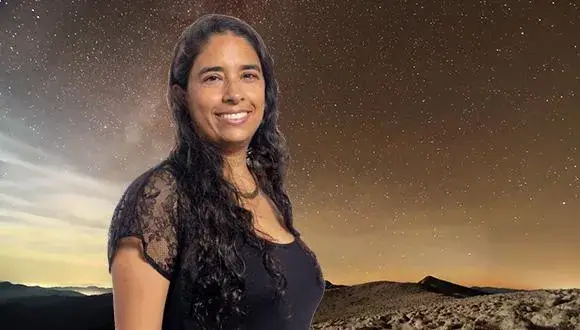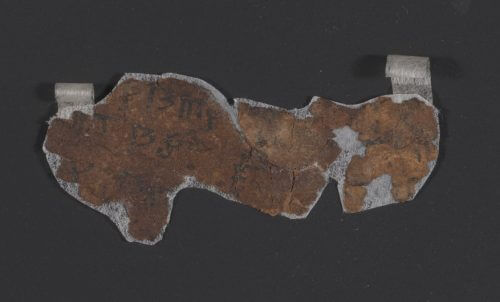Dr. Ashval Retzon integrates digital tools for the study of the ancient world and is working on new digital editions of all the astronomical scrolls and the tablet scrolls from Qumran

This week we published about an Israeli study locating the astronomical clues in the cuneiform writings of ancient Babylon. What does the future of the universe hold? In the same matter, although we are talking about documents written 1,500 years later - the Qumran Scrolls in the Judean Desert.
We are used to treating the calendar as a tool for marking important events and dates, but have you ever thought about the tremendous documentary value it holds? The calendar was and still is a tool for measuring time with important political, social and religious implications, and in archaeological and historical research it serves as an extensive base for valuable information. During the Second Temple period, for example, according to the accepted view in the research, the calendar was a cornerstone in the disputes within the Jewish society, in a period with many divisions, which even led to fratricidal wars.
Dr. Ashbel Retzon from the Cohen Institute for the History and Philosophy of Science and from the Department of Jewish Philosophy and Talmud Researches ancient Jewish science and its understanding in comparison to the science of the surrounding cultures, especially Babylonian science. In addition, she studies Jewish science in its historical, theological and cultural context. As part of her work with ancient texts, she is engaged in the reconstruction and deciphering of scrolls from the Judean Desert and the translation of manuscripts from ancient times and the Middle Ages in Hebrew, Aramaic, Greek and Gaza, and often incorporates digital tools for the study of the ancient world, focusing on the calendar and astronomical concepts during the Second Temple period.
Glue the tears of the scroll with copy paste
Scrolls of the Judean Desert is a collective name for about 25,000 pieces of parchment and papyrus discovered since 1947, most of them in the caves of Qumran and some in other sites in the Judean Desert. Among other things, the sections contain the earliest copies of the books of the Bible. Today, the scrolls are treated in the laboratories of the Jerusalem Antiquities Authority, where they are monitored using advanced scientific methods, and preserved under conditions that simulate the conditions in which they survived in the caves for 2,000 years. Since the historic discovery, researchers have faced the enormous challenge of sorting through the remains and reassembling them into nearly 1,000 scrolls, most of which were hidden in the Qumran caves, on the eve of the destruction of the Second Temple in 70 AD. Another major challenge is to try and understand to what extent the library of the Qumran caves reflects the entire spiritual world in the late Second Temple period, or whether it is an unrepresentative collection of one group, members of an unusual sect (which most scholars identify with the Essenes), which happened to come into our hands.

According to Dr. Ratzon, "the group living in Qumran withdrew from the center in Jerusalem and was in constant conflict with the majority of the people. The scrolls were compiled in the second half of the first millennium BCE, and collected in Qumran in the last centuries of the Second Temple period. Their settlement was destroyed by the Romans during the Great Revolt, and they probably hid them because of the difficult political situation in the country. The found scrolls contain both texts that were accepted by the whole nation, as well as internal sectarian texts. It can be seen that some of the scientific texts that were included in the scrolls predate the establishment of the sect, but they attached great importance to them and created their own unique calendar from them, which did not allow them to celebrate the holidays with permission in the temple. They were a very militant group. As the sect became more and more closed, it no longer relied on the prevailing scientific approaches, but continued to write about it through interpretations and acquaintance with its internal texts."
"In fact, the first astronomical Jewish texts we find are in the Qumran scrolls," explains Dr. Ratzon. "In the Bible there is almost no reference to these issues, except for sentences here and there, as in the creation of the world. In my research, I analyze how they perceived time and space during the Second Temple period, and I do this using the digital tools of scroll reconstruction. In order to check this issue to the end, you need to know better what is written in the scrolls. The scrolls crumbled into many parts, and the way to know what is written there is not only to read each section separately, but to put it together, to do the puzzle, to reconstruct what was written and not preserved. And here we use digital tools. "
Comparison with particularly ancient vanishings
"The Antiquities Authority photographed the fragments of the scrolls with a special infrared technology. We work on the computer with the images, and use computer graphics tools. We connect the sections, make a font from the writer's handwriting, and try to add the missing sections. Many scientific texts repeat themselves, so they are texts that, in terms of language, are easier to complete into sentences. If the formula is missing, for example, we can complete it, because we already found it in another part. I have a bachelor's degree in physics, so I use mathematical equations. For example, when there is only a few data, and we know the way of thinking and the structures, and we have data from a few days of the year, it is possible to reconstruct according to this what was the equation that leads them. I do the calculation and find the missing constants. "
"I read all the astronomical scrolls, reconstruct them and the scientific theory in them, and build from this their more comprehensive view of time, space and astronomy. The two major scientific centers at that time are in Babylon and Egypt. The Hellenistic center no longer sits in Athens but in Alexandria. The Jewish astronomers did not sit in the scientific center of the world at that time, and it can be seen that the Qumran scrolls have less Greek influence, but there is Babylonian influence, which scholars have already seen before me. The Babylonian influence shows that they are people, at least some of them or in different periods, are involved and know science that exists. On the other hand - they produce independent theories and their considerations in choosing a theory are not only scientific accuracy. They know the general phenomena, but they do not choose the most accurate theory, because of religious considerations, to fit traditional worldviews. In the field of astronomy, they were mainly interested in the sunrise and sunset times of the sun and the moon and the position on the horizon, which were also used for calendar matters, which was, as mentioned, a very central issue during the Second Temple period."
"You can see that they also strive for the scientific theories to be more symmetrical, so they will make the results more consistent, rounded, so that they are more beautiful," adds Dr. Ratzon. "This also has a theological background, because God created the world and it should be beautiful, not made up of messy numbers. There is an even mystical perception regarding numbers - that there should be beautiful relationships between them. We can summarize and conclude that their theories were not always the most accurate, but they have aesthetic values."
More of the topic in Hayadan:
- Free will: everything is expected and permission is given.
- The theory that conquered the scrolls
- Put together the puzzle of the hidden scrolls using the DNA of the animals from whose skins the cards were made
- One of the last two undeciphered Qumran scrolls has been recovered
- 60 years later, remains of the scrolls were discovered buried in another cave in the Judean desert
